The Sound of Her Own Voice
Ever notice how when something’s been on your mind, you start to bump into it everywhere?
Well, one of my students asked me an important (and gigantic) question a few weeks ago. She wanted to know – since singers learn by imitating and there are so many songs and singers to admire and emulate – how could she sound original?
In other words, how do you sound like … you?
Well … I have asked myself this question on and off again for over a decade and I have been really thinking about my “sound” for the last year or so. What do I want to sing? For whom? What am I trying to “accomplish” vocally? (BTW – I don’t mean accomplish in finger-wagging, critical way, but in a why do I do this? and what do I want to get out of it? kind of way.)
Something can happen when you start performing and marketing your singing and, by extension, yourself. You start trying to hit a “sweet spot” of sorts. You look for songs that your audiences will enjoy. Songs your audience can imagine you singing. You start thinking about who that audience is (or who you think that audience should be) and how you can appeal to them. If you’re honest (and want to keep working), you confront what you are and what you are not as a vocalist.
In short, the process of choosing what to sing can shift from inside yourself to outside yourself.
…
Last month, I was in Massachusetts with my mom for the birth of my niece. We were talking about my role curating the vocal nights at Jazz Central Studios and how it was requiring me to think about what jazz, particularly vocal jazz, is.
So my mom naturally asked me, “So, what is jazz?”
(cue crickets chirping)
Jazz is a style of music. It’s dance music. It’s American music. It’s a music in which harmony is as important as the melody. (Kind of.) It employs swung 8th notes (except when it doesn’t). It uses certain instrumentation (except when it doesn’t) It’s often instrumental (except when it’s not) …
I was bemused to find that I didn’t have a good answer. At all.
(To me, a good answer is an answer that you could give an eight-year-old and that eight-year-old would understand you *smile*).
So I went online and found a truly staggering (and frequently contrary) amount of information about what jazz music encompasses and the many styles and sub-genres it includes.
…
For me, jazz sits at an intersection of the sounds, history and feeling of its many, many icons crossed with the tones, stories and needs of present day makers and listeners. It is an African American art form in that the history, experiences and approaches of black Americans are embedded in its sounds and structures and its individualized interconnectedness. (Not quite a definition for our eight-year-old.)
Jazz is a dynamic genre, incorporating improvisation and exploration. And, while there is music that is certainly part of what I would call a jazz canon, jazz isn’t static and I don’t think my own jazz music can or will be found sitting safely inside what others have already created. (Darn.)
Which goes right back to my student’s question. How do we take all this input, all these influences, all these singers and their sounds and stay/become ourselves? How do I even sing jazz originally, let alone create it? (In fact, I am singing a show next week in which I search for some musical answers to this very question.) How does my student sound like herself?
I am not sure I have good answers, but here are some thoughts:

- Sing. A lot.
- Sing a lot a cappella. I have been thinking a lot about tone.
- Listen to everybody and everything. Most of this art-making/music-making thing is about ideas and inspiration.
- Read and write. I am learning that learning stuff and what you think about the stuff you are learning is a huge part of art-/music-making
- Experiment. You have to try on clothes to see if they fit; try on different songs and styles to see what suits you (and what doesn’t).